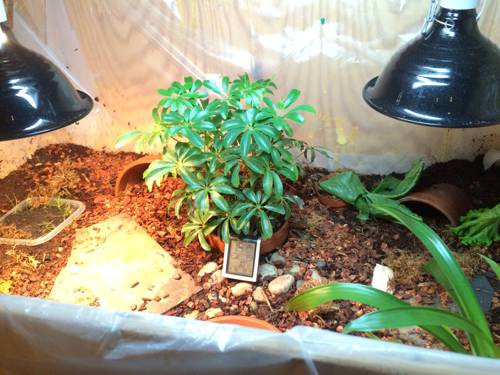
FAQ About Indoor Plant Bioactive Substrate Creation

What is a bioactive substrate for indoor plants?
A bioactive substrate for indoor plants is a type of soil that incorporates organic and often living components to create a miniature ecosystem. This substrate aims to mimic natural environments, promoting healthy plant growth and sustaining beneficial microbes, fungi, and in some cases, small invertebrates. It enhances nutrient availability and encourages natural processes like decomposition and nutrient cycling.

Why should I use a bioactive substrate for my indoor plants?
Using a bioactive substrate for indoor plants provides several benefits: it improves soil aeration, enhances organic matter decomposition, increases nutrient availability, and supports the growth of beneficial microorganisms. This creates a healthier root environment, reducing the need for chemical fertilizers and promoting increased growth and vitality of plants.

What are the main components of a bioactive substrate?
A typical bioactive substrate for indoor plants includes components like organic matter (such as leaf litter or coco coir), mineral content (such as sand or perlite), and living organisms (like beneficial fungi, bacteria, and sometimes small invertebrates). These components work together to create a balanced and sustainable environment for plant growth.

How do I create a bioactive substrate for indoor plants?
To create a bioactive substrate, start by selecting a base medium such as coco coir or peat moss. Add components like sand or perlite to improve drainage, and incorporate organic matter such as decomposed leaves or compost. Introduce living elements such as mycorrhizal fungi or beneficial bacteria to enhance microbial activity. Mix these components thoroughly to establish a healthy, thriving environment for your plants.

Can all indoor plants benefit from a bioactive substrate?
While most indoor plants can benefit from a bioactive substrate, it is particularly advantageous for species that thrive in naturally rich soil conditions, such as tropical plants. Some plants with minimal nutrient needs or those that prefer very specific soil conditions may not require a bioactive substrate.

How often should I change the bioactive substrate for indoor plants?
Unlike traditional potting mixes, a well-maintained bioactive substrate doesn't need frequent changing. Regular assessments of the substrate's health, including checks for compactness, nutrient level, and biological activity, can help determine when to refresh or replace it. Typically, if maintained properly, such substrates can last for several years.

What are the signs that a bioactive substrate is functioning properly?
Signs of a properly functioning bioactive substrate include healthy plant growth, minimal pest issues, and the presence of beneficial organisms like earthworms or fungi. Soil should be crumbly and aerated, with no foul odor, indicating that organic matter is decomposing effectively.

Are there any plants that should not be grown in bioactive substrates?
Certain plants with specific soil needs, such as succulents or carnivorous plants, may not thrive in a bioactive substrate due to their preference for low organic matter environments. It is essential to consider the natural habitat of the plant before choosing a substrate type.

What role do beneficial microorganisms play in bioactive substrates?
Beneficial microorganisms in bioactive substrates play crucial roles in decomposing organic material, making nutrients more available to plants, and enhancing root growth. They interact with plant roots to improve nutrient uptake and help protect plants from pathogens, contributing to overall plant health.

Can I use kitchen scraps in my bioactive substrate?
While some kitchen scraps can be used to enhance a bioactive substrate, it is important to compost them first to avoid attracting pests or introducing pathogens. Properly composted materials such as vegetable peelings can provide additional nutrients to the substrate.

Do bioactive substrates require fertilizers?
Bioactive substrates typically reduce the need for chemical fertilizers as they naturally recycle nutrients. However, supplemental feeding might be necessary for heavy-feeding plants or to address specific nutrient deficiencies. Organic fertilizers are preferable to avoid disrupting the microbial ecosystem.

How does a bioactive substrate improve plant health compared to regular soil?
Bioactive substrates improve plant health by providing a balanced ecosystem that supports natural biological processes. The increased microbial activity ensures that nutrients are available in a form that plants can readily uptake, leading to robust growth and resilience against diseases.

Are there commercial products available for bioactive substrates?
Yes, there are commercial products available designed as bioactive substrates, typically formulated with beneficial microbes, organic matter, and other essential components. These can be a convenient option for those who prefer not to create their substrate from scratch.

How do earthworms benefit a bioactive substrate?
Earthworms are beneficial in a bioactive substrate as they aerate the soil and help break down organic material into forms more readily used by plants. Their activity increases nutrient availability and enhances soil structure, promoting healthy root growth.

Can I use a bioactive substrate in a terrarium?
Yes, bioactive substrates are ideal for terrarium environments because they support a balanced micro-ecosystem. They help manage humidity and decomposition within the enclosed space, making them perfect for maintaining plant health and a self-sustaining environment.

What is the difference between bioactive substrate and hydroponics?
Bioactive substrates involve organic materials and microorganisms to maintain plant health, whereas hydroponics typically uses a nutrient solution without soil or bioactive components. Bioactive substrates rely on a balanced ecosystem, while hydroponics is more reliant on precise control of nutrient delivery.

How do I maintain the health of a bioactive substrate?
Maintaining a bioactive substrate involves regular monitoring of moisture levels and the balance of components, adjusting as necessary. Avoid over-watering to prevent pathogens, and occasionally top-dress with compost or organic material to sustain nutrient levels and microbial activity.

What are some examples of living organisms included in bioactive substrates?
Common living organisms used in bioactive substrates include mycorrhizal fungi, beneficial bacteria, and sometimes small fauna like springtails and earthworms. These organisms contribute to the decomposition process, nutrient cycling, and plant root health.

Can I make my own bioactive substrate at home?
Yes, creating a bioactive substrate at home is possible with a few simple components. By using a mixture of organic materials, mineral additives, and inoculating with beneficial microbes, you can craft an effective substrate tailored to your plant's specific needs.

Does a bioactive substrate support pest control in indoor plants?
Bioactive substrates can help manage pest populations by maintaining a healthy micro-ecosystem that supports natural predators and beneficial insects. This can reduce the reliance on chemical pesticides, contributing to a more balanced and sustainable growing environment.
